Python Programming Certification Course
- 66k Enrolled Learners
- Weekend/Weekday
- Live Class
Python is a programming language that is used for general-purpose programming. It is a high-level, interpreted, and object-oriented language. Python has been around since 1991 and has become one of the most popular languages in the world. This language is an easy-to-learn language with a simple syntax and can be learned by anyone who knows how to program in any other language, like C, Java, or JavaScript. You can see the list below for the topics this blog will cover:
Python in simple words is a High-Level Dynamic Programming Language which is interpreted. Guido Van Rossum, the father of Python had simple goals in mind when he was developing it, easy looking code, readable and open source. Python is ranked as the 3rd most prominent language followed by JavaScript and Java in a survey held in 2018 by Stack Overflow which serves proof to it being the most growing language.
To get in-depth knowledge on Python Programming language along with its various applications, you can enroll now for Python course Certification training with 24/7 support and lifetime access.
Python is currently my favorite and most preferred language to work on because of its simplicity, powerful libraries, and readability. You may be an old school coder or may be completely new to programming, Python is the best way to get started!
Python provides features listed below :
To sum it up, Python has a simple syntax, is readable, and has great community support.
Python is an interpreted language, meaning the interpreter reads the code and executes it line by line. The interpreter can execute Python code from the command line or within an IDE (Integrated Development Environment).
The Python interpreter can execute Python code from the command line or within an IDE (Integrated Development Environment).
In this Python tutorial blog, we’ll show you how to install python no matter which operating system you use. You can follow the steps given below and if you have any queries during the process, feel free to leave a comment.
Python Installation For Windows
But do we pick the 32-bit or the 64-bit installer?
For Windows, you can choose either the 32-bit or 64-bit installer. Here’s what the difference between the two comes down to:
Open the installer and click on “Run”.
Use the Graphical linux installation to install python on linux. Follow the steps below:
Python is ready for use.
Before installing Python, you’ll need to install GCC. GCC can be obtained by downloading Xcode, the smaller Command Line Tools or the even smaller OSX-GCC-Installer package.
While OS X comes with a large number of Unix utilities, those familiar with Linux systems will notice one key component missing: a package manager. Homebrew fills this void.
Once you’ve installed Homebrew, insert the Homebrew directory at the top of your PATH environment variable. You can do this by adding the following line at the bottom of your ~/.profile file
export PATH="/usr/local/opt/python/libexec/bin:$PATH"
Now, we can install Python 3:
$brew install python
IDE typically provides code editor, compiler/ interpreter and debugger in one GUI (Graphical User Interface). It encapsulates the entire process of code creation, compilation and testing which increases the productivity of developers.
A developer working with an IDE starts with a model, which the IDE translates into suitable code. The IDE then debugs and tests the model-driven code, with a high level of automation. Once the build is successful and properly tested, it can be deployed for further testing through the IDE or other tools outside of the IDE.
Always keep the following points in mind while choosing the best IDE for Python:
Once these points are decided upon, the programmer can easily select among the IDEs based on the given features.
Developed by Czech company JetBrains, PyCharm is an IDE specific to Python. PyCharm is a cross-platform IDE. Therefore, users may download any of the Windows, Mac or Linux versions depending on their requirements. Honestly, PyCharm is considered to be one of the best IDE for Python and justifiably the most widely used.
In addition to the common features, PyCharm provides additional features like:
It provides two versions for download, the Community version which is free and the paid Professional version. Programmers can download the corresponding versions as per their requirements
Go to www.jetbrains.com/pycharm/download/#section=windows

Here, the community version is free, but for the professional version, you need to buy the license. I will be working on the PyCharm community version.
In this Python tutorial, we’ll also see how to use Pycharm, I will walk you through the interface.
Let us begin by creating a new project. PyCharm greets you with the following image as soon as you open it:
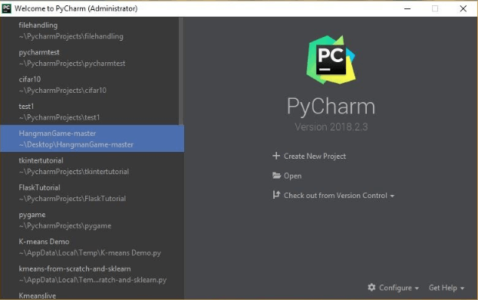 Here, on the left, you can check out all of the recent projects that I have been working with. But if this is your first time using PyCharm, then the column on the left will not contain anything.
Here, on the left, you can check out all of the recent projects that I have been working with. But if this is your first time using PyCharm, then the column on the left will not contain anything.
Creating a new project is as easy as clicking on the Create New Project tab and going from there.

This image basically helps us set up our Python Interpreter. However, this might be blank if you do not have Python installed on your system.

Clicking on the little gear icon on the right will bring up the following page:

Here, you can make use of the System Interpreter if you have not installed Python separately. Do check the version of the Python installation that is present so it meets your requirements.
Jupyter Notebooks are a powerful way to write and iterate on your Python code for data analysis. Jupyter Notebook is built off of IPython and the Kernel runs the computations and communicates with the Jupyter Notebook front-end interface.
Jupyter Notebook is an open-source web application that allows you to create and share documents that contain live code, equations, visualizations and narrative text. It is used for data cleaning and transformation, numerical simulation, statistical modeling, data visualization, machine learning, and much more.
Python’s syntax is very easy to understand. The lines of code required for a task is less compared to other languages. Let me give you an example – If I have to print “Welcome To Edureka!” all I have to type:
print('Welcome To Edureka!')
Let’s look at some cool features of Python:
If you are wondering where you can use Python (Python Application), let me tell you that is where Python stands out.
It is advantageous over other programming languages because it is a:
Python is a programming language created by Guido van Rossum in the late 1980s. It is a high-level, general-purpose programming language that can be used for many applications. The language is easily extensible and has a large and vibrant open-source community.
Python has two main implementations
Which have an identical syntax but different functionality. Python is considered a ‘meta-programming’ language because its expressiveness allows new programs to be created by writing just one line of code in the interpreter or a separate file. This programming language includes features such as recursion, first-class functions, closures, and explicit typing.
Python version 2.0 was made public on the 16th of October 2000, with many brand new features, including a cycle-detecting garbage collector and support for Unicode.
Python version 3.0 was made public on the 3rd of December 2008. It was a crucial revision of the programming language that is not completely backward-compatible. A lot of its vital features were backported to Python 2.6. As well as the 2.7 version series. Further version releases of the Python 3 series included the utility of 2 to 3, which automates (at least partially) the translation of Python 2 code to Python 3.
Python version 2.7 closing date was initially set in 2015 then was postponed to 2020 out of concern that a large body of existing code could not easily be forward-ported to Python 3. Now there won’t be any more security patches or other improvements will be released for it. With Python 2 life outdation, only Python 3.6.x and later are supported.
Python 3.9.2 and 3.8.8 were accelerated as all of the versions of Python (including 2.7) had security issues, leading to possible remote code execution and web cache poisoning.
| Sl.no | Python 2 | Python 3 |
| 1. | It does the approximation i.e it rounds up to the closest whole number in the integer division (7 divided by 2 returns 3) | It gives the accurate result (7 divided by 2 returns 3.5). Integer division in Python 3 becomes strikingly accurate, resulting in accurate values |
| 2. | It’s syntax is difficult to understand | The syntax when compared is simpler and can be easily understood. |
| 3. | The storage needs to define the Unicode string value with “u”. | The default storage of strings is Unicode. |
| 4. | The value of the global variable will be changed whenever it will be used inside a for-loop. | The value of variables doesn’t change. |
| 5. | Exceptions are enclosed in notations. | Exceptions are enclosed in parenthesis. |
| 6. | The ordering comparison rules are comparatively complex. | The ordering comparisons rules are quite simple. |
| 7. | In this version the xrange() is used for iterations. | It provides a Range() function to perform iterations. |
Python is a general-purpose programming language that is used for a wide variety of applications. It is an interpreted, object-oriented, high-level programming language with a design philosophy emphasizing code readability In this python tutorial, we think it is necessary that you understand its applications.
The language has an extensive standard library and many third-party modules. These libraries and modules can be used to develop desktop applications, web applications, and games. These applications have been explained briefly below:
Let us now start coding in Python.
The basic concepts in any programming language are the foundation of any programmer, We will start with the most basic concept in python.
Keywords are nothing but special names that are already present in python. We can use these keywords for specific functionality while writing a python program.
Following is the list of all the keywords that we have in python:

Syntax and Usage
import keyword
keyword.kwlist
#this will get you the list of all keywords in python.
keyword.iskeyword('try')
#this will return true, if the mentioned name is a keyword.
Identifiers are user defined names that we use to represent variables, classes, functions, modules etc.
name = 'edureka' my_identifier = name
This Python tutorial will also explain some of the most popular python libraries
programmer-coherent statements, that describe what a block of code means. They get very useful when you are writing large codes. It’s practically inhuman to remember the names of every variable when you have a hundred-page program or so. Therefore, making use of comments will make it very easy for you, or someone else to read as well as modify the code.
#this is a single line comment #this is a multi #line comment """this is a docstring comment i hope it is clear """
A block comment in python is written with the same indentation as the code, it is used to explain the code. A block comment looks something like the one written in the example below.
# this is a print statement print(‘hello world’)
Variables are nothing but reserved memory locations to store values. This means that when you create a variable you reserve some space in memory.
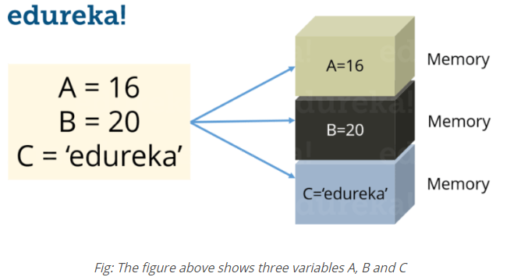
In Python you don’t need to declare variables before using it, unlike other languages like Java, C etc.
Python variables do not need explicit declaration to reserve memory space. The declaration happens automatically when you assign a value to a variable. The equal sign (=) is used to assign values to variables. Consider the below example:
Syntax
S = 10 print(S)
This will assign value ‘10’ to the variable ‘S’ and will print it. Try it yourself.
In python, GLOBAL Keyword can be used to access/modify the variables out of the current scope.
A = 10 Def function(): global a A += 10 print(A) print(A) function()
Python supports various data types, these data types define the operations possible on the variables and the storage method. In this section of the Python tutorial, we’ll go through some of the commonly used data types in Python.
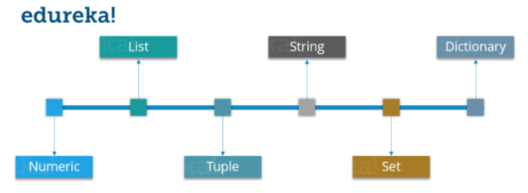
Let’s discuss each of these in detail. In this Python tutorial, we’ll start with ‘STRINGS’ data type.
Strings are among the most popular data types in Python. We can create them simply by enclosing characters in quotes. Python treats single and double quotes in exactly the same fashion. Consider the example below:
Syntax
S= "Welcome To edureka!" D = 'edureka!'
Some of the string methods used in python are written below:
Formatting a string means to allocate the string dynamically wherever you want.
Strings in Python can be formatted with the use of format() method which is very versatile and powerful tool for formatting of Strings. Format method in String contains curly braces {} as placeholders which can hold arguments according to position or keyword to specify the order.
Example
String1 = "{1} {0} {2}".format('Hello', 'to', 'Batman')
print("nPositional order: ")
print(String1)
Positional order:
to Hello Batman
Just as expected Numeric data types store numeric values. They are immutable data types, this means that you cannot change its value. Python supports three different Numeric data types:
It holds all the integer values i.e. all the positive and negative whole numbers, example – 10.
It holds the real numbers and are represented by decimal and sometimes even scientific notations with E or e indicating the power of 10 (2.5e2 = 2.5 x 102 = 250), example – 10.24.
These are of the form a + bj, where a and b are floats and J represents the square root of -1 (which is an imaginary number), example – 10+6j.
These are the decisive data types, they only return categorical value, i.e true or false.
Now you can even perform type conversion. For example, you can convert the integer value to a float value and vice-versa. Consider the example below:
Syntax And Usage
A = 10 # Convert it into float type B = float(A) print(B)
The code above will convert an integer value to a float type. Similarly you can convert a float value to integer type:
A = 10.76 # Convert it into float type B = int(A) print(B)
You can consider the Lists as Arrays in C, but in List you can store elements of different types, but in Array all the elements should of the same type.
List is the most versatile datatype available in Python which can be written as a list of comma-separated values (items) between square brackets. Consider the example below:
Syntax
subjects = ['physics', 'chemistry','biology'] print(subjects)
Output:['physics, 'chemistry','biology']
Notice that the Subjects List contains both words as well as numbers. Now, let’s perform some operations on our Subjects List.
Let’s look at few operations that you can perform with Lists:
a = [1,2,3,4,11,5] a.remove(11) #this will remove 11 from the list.
Follow the steps below to remove duplicates from a list
Mylist = [a,b,c,b,c,a,c,a] b = list(dict.fromkeys(Mylist)) print(b)
A Tuple is a sequence of immutable Python objects. Tuples are sequences, just like Lists. We will see the differences between tuples and lists in this python tutorial.
Syntax
chelsea = ('hazard', 'terry', 'lampard')
Now you must be thinking why Tuples when we have Lists?
So the simple answer would be, Tuples are faster than Lists. If you’re defining a constant set of values that you just want to iterate, then use Tuple instead of a List.
Guys, all Tuple operations are similar to Lists, but you cannot update, delete or add an element to a Tuple.
Now, stop being lazy and don’t expect me to show all those operations, try it yourself.
A Set is an unordered collection of items. Every element is unique.
A Set is created by placing all the items (elements) inside curly braces {}, separated by a comma. Consider the example below:
Syntax
set_name = {1,2,3,4,5}
In Sets, every element has to be unique. Try printing the below code:
set_2 = {1,2,3,3,4,5}
Here 3 is repeated twice, but it will print it only once.
Let’s look at some Set operations:
Union of A and B is a set of all the elements from both sets. Union is performed using | operator. Consider the below example:
A = {1, 2, 3, 4}
B = {3, 4, 5, 6}
print ( A | B)
Output = {1, 2, 3, 4, 5, 6}Intersection of A and B is a set of elements that are common in both sets. Intersection is performed using & operator. Consider the example below:
A = {1, 2, 3, 4}
B = {3, 4, 5, 6}
print ( A ^ B )
Output: {3,4}
Difference of A and B (A – B) is a set of elements that are only in A but not in B. Similarly, B – A is a set of element in B but not in A. Consider the example below:
A = {1, 2, 3, 4, 5}
B = {4, 5, 6, 7, 8}
print(A - B)
Output: {1,2,3}
Any python tutorial is worthless without a proper explanation of dictionaries. Now let me explain you Dictionaries with an example.
I am guessing you guys know about Aadhaar Card. For those of you who don’t know what it is, it is nothing but a unique ID which has been given to all Indian citizen. So for every Aadhaar number, there is a name and few other details attached.
Now you can consider the Aadhaar number as a ‘Key’ and the person’s detail as the ‘Value’ attached to that Key.
Dictionaries contains these ‘Key Value’ pairs enclosed within curly braces and Keys and values are separated with ‘:’. Consider the below example:
Syntax
dictionary_name = {key: value, key2: value2}
You know the drill, now comes various Dictionary operations.
Dict = {'Name' : 'Saurabh', 'Age' : 23}
print(Dict['Name'])
Output = Saurabh
Dict = {'Name' : 'Saurabh', 'Age' : 23}
Dict['Age'] = 32
Dict['Address'] = 'Starc Tower'
Output = {'Name' = 'Saurabh', 'Age' = 32, 'Address' = 'Starc Tower'}
Operators are the constructs which can manipulate the values of the operands. Consider the expression 2 + 3 = 5, here 2 and 3 are operands and + is called operator.
Python supports the following types of Operators:

Let’s focus on each of these Operators one by one.
These Operators are used to perform mathematical operations like addition, subtraction etc. Assume that A = 10 and B = 20 for the below table.
| Operator | Description | Example |
| + Addition | Adds values on either side of the operator | A + B = 30 |
| – Subtraction | Subtracts the right hand operator with left hand operator | A – B = -10 |
| * Multiplication | Multiplies values on either side of the operator | A * B = 200 |
| / Division | Divides left hand operand with right hand operator | A / B = 0.5 |
| % Modulus | Divides left hand operand by right hand operand and returns remainder | B % A = 0 |
| ** Exponent | Performs exponential (power) calculation on operators | A ** B = 10 to the power 20 |
Consider the example below:
a = 21 b = 10 c = 0 c = a + b print ( c ) c = a - b print ( c ) c = a * b print ( c ) c = a / b print ( c ) c = a % b print ( c ) a = 2 b = 3 c = a**b print ( c )
Output = 31, 11, 210, 2.1, 1, 8Now let’s see comparison Operators.
These Operators compare the values on either sides of them and decide the relation among them. Assume A = 10 and B = 20.
| Operator | Description | Example |
| == | If the values of two operands are equal, then the condition becomes true. | (A == B) is not true |
| != | If values of two operands are not equal, then condition becomes true. | (A != B) is true |
| > | If the value of left operand is greater than the value of right operand, then condition becomes true. | (a > b) is not true |
| < | If the value of left operand is less than the value of right operand, then condition becomes true. | (a < b) is true |
| >= | If the value of left operand is greater than or equal to the value of right operand, then condition becomes true. | (a >= b) is not true |
| <= | If the value of left operand is less than or equal to the value of right operand, then condition becomes true. | (a <= b) is true |
Consider the example below:
a = 21
b = 10
c = 0
if ( a == b ):
print ("a is equal to b")
else:
print ("a is not equal to b")
if ( a != b ):
print ("a is not equal to b")
else:
print ("a is equal to b")
if ( a < b ): print ("a is less than b") else: print ("a is not less than b") if ( a >b ):
print ("a is greater than b")
else:
print ("a is not greater than b")
a = 5
b = 20
if ( a<= b ): print ("a is either less than or equal to b") else: print ("a is neither less than nor equal to b") if ( a => b ):
print ("a is either greater than or equal to b")
else:
print ("a is neither greater than nor equal to b")
Output = a is not equal to b
a is not equal to b
a is not less than b
a is greater than b
a is either less than or equal to b
b is either greater than or equal to bNow in the above example, I have used conditional statements (if, else). It basically means if the condition is true then execute the print statement, if not then execute the print statement inside else. We will understand these statements later in this Python Tutorial blog.
An Assignment Operator is the operator used to assign a new value to a variable. Assume A = 10 and B = 20 for the below table.
| Operator | Description | Example |
| = | Assigns values from right side operands to left side operand | c = a + b assigns value of a + b into c |
| += Add AND | It adds right operand to the left operand and assigns the result to left operand | c += a is equivalent to c = c + a |
| -= Subtract AND | It subtracts right operand from the left operand and assigns the result to left operand | c -= a is equivalent to c = c – a |
| *= Multiply AND | It multiplies right operand with the left operand and assigns the result to left operand | c *= a is equivalent to c = c * a |
| /= Divide AND | It divides left operand with the right operand and assigns the result to left operand | c /= a is equivalent to c = c / a |
| %= Modulus AND | It takes modulus using two operands and assign the result to left operand | c %= a is equivalent to c = c % a |
| **= Exponent AND | Performs exponential (power) calculation on operators and assign value to the left operand | c **= a is equivalent to c = c ** a |
Consider the example below:
a = 21 b = 10 c = 0 c = a + b print ( c ) c += a print ( c ) c *= a print ( c ) c /= a print ( c ) c = 2 c %= a print ( c ) c **= a print ( c )
Output = 31, 52, 1092, 52.0, 2, 2097152, 99864These operations directly manipulate bits. In all computers, numbers are represented with bits, a series of zeros and ones. In fact, pretty much everything in a computer is represented by bits. Consider the example shown below:
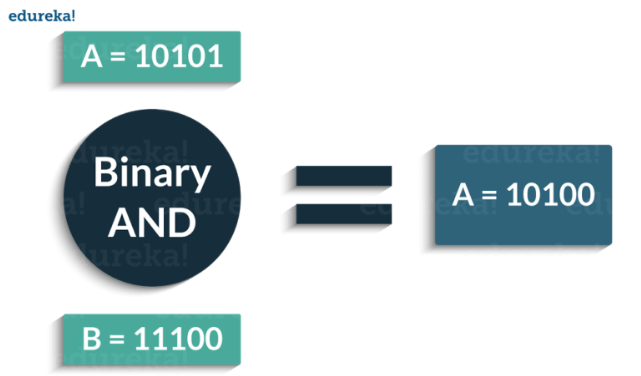
Following are the Bitwise Operators supported by Python:
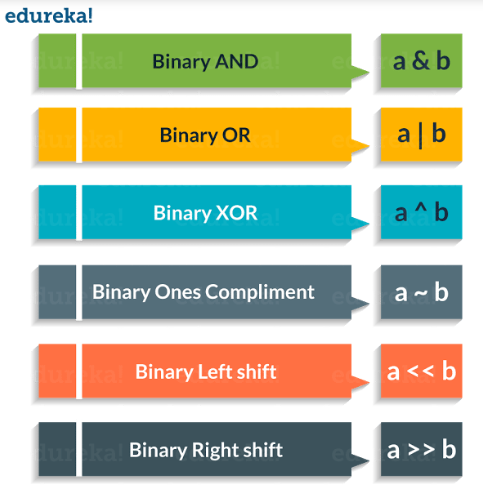
Consider the example below:
a = 58 # 111010 b = 13 # 1101 c = 0 c = a &b print ( c ) # 8 = 1000 c = a | b print ( c ) # 63 = 111111 c = a ^ b print ( c ) # 55 = 110111 c = a <<2 print ( c ) # 232 = 11101000 c = a >>2 print ( c ) # 14 = 1110
Output = 8,63,55,232,14Next up, in this Python Programming Tutorial for Beginners we will focus on Logical Operators.
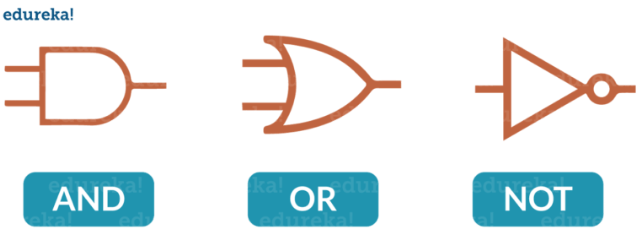 The following are the Logical Operators present in Python:
The following are the Logical Operators present in Python:
| Operator | Description | Example |
| and | True if both the operands are true | X and Y |
| or | True if either of the operands are true | X or Y |
| not | True if operand is false (complements the operand) | not X |
Consider the example below:
x = True
y = False
print('x and y is',x and y)
print('x or y is',x or y)
print('not x is',not x)
Now in Python Tutorial, we’ll learn about Membership Operators.
These Operators are used to test whether a value or a variable is found in a sequence (Lists, Tuples, Sets, Strings, Dictionaries) or not. The following are the Membership Operators:
| Operator | Description | Example |
| in | True if value/variable is found in the sequence | 5 in x |
| not in | True if value/variable is not found in the sequence | 5 not in x |
Consider the example below:
X = [1, 2, 3, 4] A = 3 print(A in X) print(A not in X)
Output = True
False
Next in Python Tutorial, it’s time we understand the last Operator i.e. Identity Operator.
These Operators are used to check if two values (or variables) are located on the same part of the memory. Two variables that are equal does not imply that they are identical.
Following are the Identity Operators in Python:
| Operator | Description | Example |
| is | True if the operands are identical | x is True |
| is not | True if the operands are not identical | x is not True |
Consider the example below:
X1 = 'Welcome To edureka!' X2 = 1234 Y1 = 'Welcome To edureka!' Y2 = 1234 print(X1 is Y1) print(X1 is not Y1) print(X1 is not Y2) print(X1 is X2)
False
True
False
Consider the flowchart shown below:
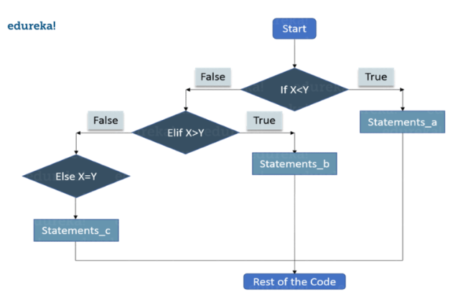
Let me tell you how it actually works.
Syntax
if condition1:
statements
elif condition2:
statements
else:
statements
X = 10
Y = 12
if X <Y: print('X is less than Y') elif X >Y:
print('X is greater than Y')
else:
print('X and Y are equal')
Output: X is less than Y
This python tutorial will also explain loops. In general, statements are executed sequentially. The first statement in a function is executed first, followed by the second, and so on
There may be a situation when you need to execute a block of code several number of times
A loop statement allows us to execute a statement or group of statements multiple times. The following diagram illustrates a loop statement:
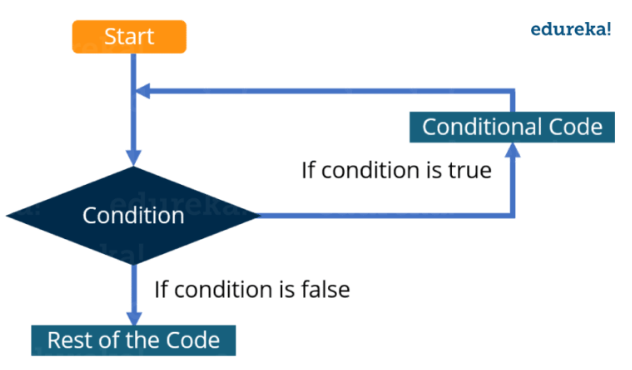 Let me explain you the above diagram:
Let me explain you the above diagram:
There are two types of loops:
There is one more way to categorize loops:
Python does not support Post-test loops.
In Python, there are three loops:
Here, first the condition is checked and if it’s true, control will move inside the loop and execute the statements inside the loop until the condition becomes false. We use this loop when we are not sure how many times we need to execute a group of statements or you can say that when we are unsure about the number of iterations.
Consider the example:
Syntax and Usage
count = 0
while (count <10):
print ( count )
count = count + 1
print ("Good bye!")
Output = 0
1
2
3
4
5
6
7
8
9
Good bye!Like the While loop, the For loop also allows a code block to be repeated certain number of times. The difference is, in For loop we know the amount of iterations required unlike While loop, where iterations depends on the condition. You will get a better idea about the difference between the two by looking at the syntax:
Syntax
for variable in Sequence:
statements
Notice here, we have specified the range, that means we know the number of times the code block will be executed.
Consider the example:
fruits = ['Banana', 'Apple', 'Grapes'] for index in range(len(fruits)): print (fruits[index])
Output: BananaAppleGrapes
It basically means a loop inside a loop. It can be a For loop inside a While loop and vice-versa. Even a For loop can be inside a For loop or a While loop inside a While loop.
Consider the example:
count = 1
for i in range(10):
print (str(i) * i)
for j in range(0, i):
count = count +1
Output
1
22
333
4444
55555
666666
7777777
88888888
999999999
Now is the best time to introduce functions in this Python Tutorial.
Django
Unlike other frameworks, Django is a python based open-source & free to use web framework that includes a large number of built-in features rather than offering them as separate libraries. Django uses its ORM for mapping objects to database tables. Though Django has commendable support for MySQL, SQLite, PostgreSQL, and Oracle Database, it can also support other databases via third-party drivers.
Flask
Flask allows the developers to build up a web application foundation from which it is possible to use any extensions required, as it is a microweb framework written in Python. Flask is compatible with Google App Engine.
It is a Python framework that depends heavily on Python 3.5+ features, such as async & awaits. It allows a request object and router to authorize the redirection of queries to functions developed to handle the same.
Bottle
The bottle is a microframework that produces a single source file for each application developed. It is one of the best python web frameworks, designed to be fast, simple & lightweight. This microframework for Python was initially created for building APIs.
CherryPy
It is a famous open-source, object-oriented web application framework that follows a minimalistic approach. Any CherryPy-powered web app is a freestanding Python application with its own embedded multi-threaded web server and runs on any Operating system with support for Python as it is designed for the speedy development of web applications.
web2py
Web2py is an open-source web application framework written in the Python programming language. Web2py allows web developers to program dynamic web content using Python.
Pylons Project
This framework is an open-source project. The intention of the organization is to develop a set of web application technologies using Python.
Python has a built-in function open(), top open a file. This function returns a file object, also called a handle, as it is used to read or modify the file accordingly.
We can specify the mode while opening a file. In the mode, we specify whether we want to
The default is reading in text mode. In this mode, we get strings when reading from the file.
Syntax
o = open("edureka.txt") # equivalent to 'r' or 'rt'
o = open ("edureka.txt",'w') # write in text mode
o = open ("img1.bmp",'rb' ) # read and write in binary mode
When we are done with operations to the file, we need to properly close the file.
Closing a file will free up the resources that were tied with the file and is done using Python close() method.
o = open ("edureka.txt")
o.close()
This python tutorial will also explain what modules are in python. Modules are simply a ‘program logic’ or a ‘python script’ that can be used for variety of applications or functions. We can declare functions, classes etc in a module.
The focus is to break down the code into different modules so that there will be no or minimum dependencies on one another. Using modules in a code helps to write lesser line of codes, a single procedure developed for reuse of the code as well. It also eliminates the need to write the same logic again and again.
Built-in modules are written in C and integrated with python interpreter. Each built-in module contains resources for certain specific functionalities like Operating system management, disk input/output etc.
The standard library also has many python scripts containing useful utilities. There are several built-in modules in python at our disposal that we can use whenever we want.
Some Of the Most Common and most useful built-in modules are:
The OS module in Python is a part of the standard library of the programming language. When imported, it lets the user interact with the native OS Python is currently running on. In simple terms, it provides an easy way for the user to interact with several os functions that come in handy in day to day programming.
Example: os.popen(): This function is a part of file object manipulation and is used to open a pipe to and from a command. The return value of this function can be read or written dependent upon your use of r or w. The syntax for this function is as follows, os.popen(command[, mode[, bufsize]]). The parameters taken into consideration are, mode as well as bufsize. Take a look at the example below to understand this better.
import os
fd = "GFG.txt"
# popen() is similar to open()
file = open(fd, 'w')
file.write("Hello")
file.close()
file = open(fd, 'r')
text = file.read()
print(text)
# popen() provides a pipe/gateway and accesses the file directly
file = os.popen(fd, 'w')
file.write("Hello")
# File not closed, shown in the next function.
Some of the most important mathematical functions are defined in the math module in python, the following example shows how we can use it in a program.
import math print(math.pi) #it will print the value of pi
Functions in the random module generate a pseudo-random number using the random() function that generates that generates a float number from 0.0 to 1.0.
The following example shows how we can use random in a program in python.
import random print(random.random())
A date in python is not a type of its own, we can work on it by using the datetime module in python. The following example shows how we can use it in a program in python.
import datetime print(datetime.datetime.now()) #it will print the current date and time
OOPs refers to the Object-Oriented Programming in Python. Well, Python is not completely object-oriented as it contains some procedural functions. Now, you must be wondering what is the difference between a procedural and object-oriented programming. To clear your doubt, in a procedural programming, the entire code is written into one long procedure even though it might contain functions and subroutines. It is not manageable as both data and logic get mixed together. But when we talk about object-oriented programming, the program is split into self-contained objects or several mini-programs. Each object is representing a different part of the application which has its own data and logic to communicate among themselves. For example, a website has different objects such as images, videos etc.
A class in python is the blueprint from which specific objects are created. It lets you structure your software in a particular way. Here comes a question how? Classes allow us to logically group our data and function in a way that it is easy to reuse and a way to build upon if need to be.
Using a class, you can add consistency to your programs so that they can be used in cleaner and efficient ways. The attributes are data members (class variables and instance variables) and methods which are accessed via dot notation.
To create a class in python, consider the below example:
class employee: pass #no attributes and methods emp_1=employee() emp_2=employee() #instance variable can be created manually emp_1.first='aayushi' emp_1.last='Johari' emp_1.email='aayushi@edureka.co' emp_1.pay=10000 emp_2.first='test' emp_2.last='abc' emp_2.email='test@company.com' emp_2.pay=10000 print(emp_1.email) print(emp_2.email)
aayushi@edureka.co test@company.com
Inheritance allows us to inherit attributes and methods from the base/parent class. This is useful as we can create sub-classes and get all of the functionality from our parent class. Then we can overwrite and add new functionalities without affecting the parent class.
A class which inherits the properties is known as Child Class whereas a class whose properties are inherited is known as Parent class.
Say, I want to create classes for the types of employees. I’ll create ‘developers’ and ‘managers’ as sub-classes since both developers and managers will have a name, email and salary and all these functionalities will be there in the employee class. So, instead of copying the code for the sub-classes, we can simply reuse the code by inheriting from the employee.
class employee:
num_employee=0
raise_amount=1.04
def __init__(self, first, last, sal):
self.first=first
self.last=last
self.sal=sal
self.email=first + '.' + last + '@company.com'
employee.num_employee+=1
def fullname (self):
return '{} {}'.format(self.first, self.last)
def apply_raise (self):
self.sal=int(self.sal * raise_amount)
class developer(employee):
pass
emp_1=developer('aayushi', 'johari', 1000000)
print(emp_1.email)
Output:
aayushi.johari@company.com
This brings us to the end of this Python tutorial article where we have learned Python programming. I hope you have a clear understanding of everything that has been shared with you in this blog. If you have additional questions or suggestions, please leave a comment below and we will get back to you as soon as possible.
If you found this article on “Python tutorial” relevant, check out the Edureka’s Python Masters course, a trusted online learning company with a network of more than 250,000 satisfied learners spread across the globe.
We are here to help you with every step on your journey and come up with a curriculum that is designed for students and professionals who want to be a Python developer. The course is designed to give you a head start into Python tutorial and train you for both core and advanced Python concepts along with various Python frameworks like Django.
If you come across any questions, feel free to ask all your questions in the comments section of “Python tutorial” and our team will be glad to answer.
 Thank you for registering Join Edureka Meetup community for 100+ Free Webinars each month JOIN MEETUP GROUP
Thank you for registering Join Edureka Meetup community for 100+ Free Webinars each month JOIN MEETUP GROUPedureka.co
Extra Course is a best Python training institute in Hyderabad. We offer 100% practical driven program through our unique experimental learning, focus on comprehensive practical approach.
Good Post! Thank you so much for sharing this pretty post, it was so good to read and useful to improve my knowledge as updated one, keep blogging.
>
Thank you for this post. This is very interesting information for me. More information about the essay, see how other aspects can affect this kind of check it outIt’s really a nice experience to read your post. Thank you for sharing this useful information.
can you please tell, how the scripting for devops automation would be ?
So is there no official certification for Python? I’ve searched for exams but aside from a few courses where they state you get their “certification” after, I can not find anything. When I start a new language I like to use official certification exams objectives as my foundation for learning it.
#String in python
s=”Enter the world of ”
t=’NAVATAR’
print(s.index(“t”))
please solve the bug in this program.
it is completely fine
admin pls correct the description of len(subjects)